Major Research 1C Research on Mitigation and Restoration of Storm Surge and Wave Disasters
Background and Objectives
While Japan has not experienced a storm more devastating than the Isewan Typhoon that ravaged the nation in September 1959 in terms of severity of damage caused by storm surges and high waves, the United States and the Philippines have also been hit by catastrophic storms more recently, including Hurricane Katrina in September 2005 and Typhoon Haiyan in November 2013. In future, global warming might bring higher storm surges and waves than those we have experienced in Japan. Therefore, this research is aimed for changing disaster prevention and mitigation measures into a pre-disaster stage from post-disaster one and focuses on how to mitigate damage by the maximum storm surge and wave conditions and how to rapidly recover and reconstruct after the damage has occurred. Therefore, we conduct research to encourage hard and soft measures.
Research Topics
Research and development on the theme of mitigation of disasters caused by storm surges and high waves and disaster recovery cover the following topics:
For our research to elucidate the oceanographic phenomena based on ocean observation data, we are continuously processing and analyzing wave observation data (processing of quick reported and finalized wave data, and analysis of wave statistics).
For our research on the simulation of inundation caused by waves within ports, we are developing an inundation and drainage model to address the issue of waves overtopping on quay walls.
For our research on storm surge hazards of the highest magnitude, we are working on storm surge and inundation calculations that take into account the effects of waves, while reviewing sea surface drag coefficients under ultra-high-velocity wind conditions.
For our research on the wave forces acting on the structural members of protective facilities under storm surges, high waves, and tsunami, we are examining methods of estimating chronological changes in wave forces and also the dynamic behavior of the structural members and the ground using neural networks, etc.
Activities in FY 2020
We analyzed the wave observation data acquired through the NOWPHAS (Nationwide Ocean Wave information network for Ports and HArbourS) in 2019 and published it in the annual report. We also focused on the wave field of Typhoon Faxai, simulating it using a third-generation wave model and analyzing the wave direction (ray tracing) of the swell coming into the bay. The reproducibility of sea surface winds and Tokyo submarine canyons is crucial for the wave simulation of Tokyo Bay. Our study also indicated that the external swells that entered Yokohama Port during the typhoon might have caused significant damage to the adjacent areas.
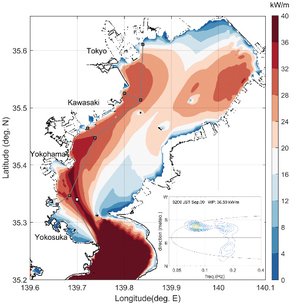
Spatial Distribution of maxium wave power
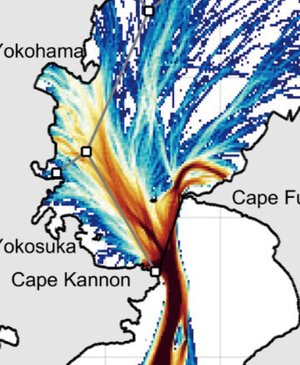
Analysis of the ray tracing of swells entering the bay
The improved version of NOWT-PARI, which can perform continuous calculations while reflecting the chronological changes in storm surges and high waves, was tested to verify its ability to monitor the inundation process of wharves, which also factored in the natural drainage caused by lowered tidal levels and decreased overtopping waves. As a result, we were also able to confirm the reproducibility of the wharf inundation that occurred in Kobe Port during Typhoon Jebi (2018).
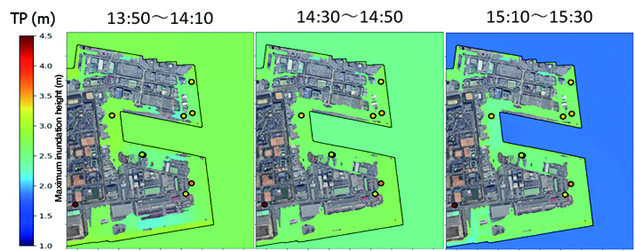
Process of inundation caused by storm surges and high waves during Typhoon Jebi (2018)
Storm surge simulations considering wave setup were conducted to reproduce the observation data of sea level deviation caused by typhoon Jebi. The effect of typhoon translation speed on the storm surge deviation and the method of setting the sea surface drag coefficient at high wind speed are investigated.
In view of the disaster that occurred in Yokohama Port during Typhoon Faxai, we conducted a large hydraulic model experiment and performed numerical simulations and elucidated the characteristics of the impulsive wave pressure acting on the setback parapet during storm surge and high waves. Based on this information, we were able to establish a method of evaluating the stability of sandbags against overtopping waves. These findings are supplementary to Case Studies of Sandbag Installations in Ports and Harbors to Mitigate Damage Caused by Storm Surges and High Waves (Ports and Harbours Bureau, Ministry of Land, Infrastructure, Transport and Tourism). We were also able to elucidate the mechanism of how energy suppression nets could reduce the wave pressure within the joint of caissons.
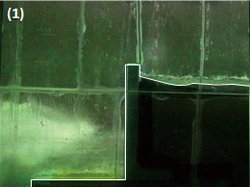
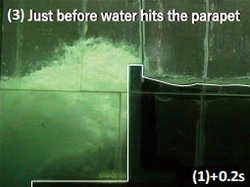
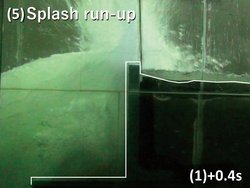
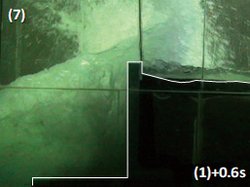
Experiment of wave force acting on setback parapet


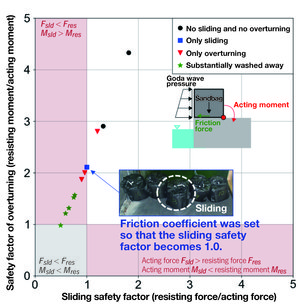
Experimental results on the stability of sandbags



